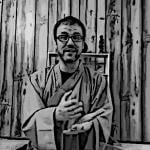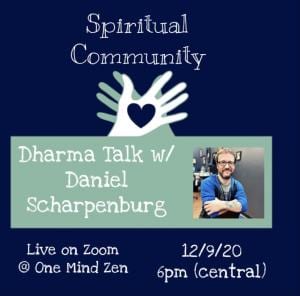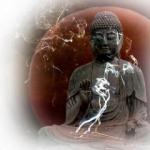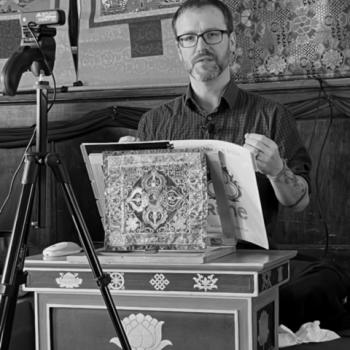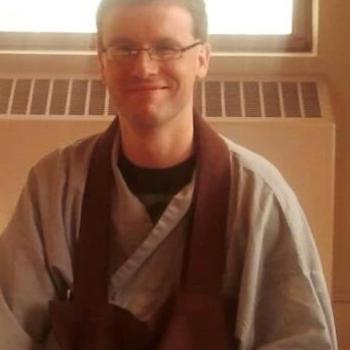This was a talk I gave at a store called Aquarius in the fall of 2019. It called it Introduction to Zen Mind. I think this will function very well as an introduction here.
======================================================
So, here we are. Zen Mind. I want this to be an opportunity to sort of explain what we’re doing and why we’re doing it, as far as Zen meditation goes. I’m going to talk about where all this comes from and where I think it’s leading us.
I was offered the chance to do a presentation, and I came up with this. I could have easily done Buddhism 101, or Who Is The Buddha, or something, but I didn’t want to do that.
First of all, we’re going to talk about why we are doing meditation practice. I’m not going to talk a lot about Buddha except to say, Buddha just means “the one who is awake,” and I’ll tell a story that features the Buddha. We’re not going to go real deep into that, because the truth is that this is not about the Buddha’s journey, or about anyone else’s, it’s about yours.
We could very easily get distracted thinking about the Buddha or any other historical figure, and not think about our own journey. I think a lot of people are prone to that.
With that being said, I am going to tell this story now, it’s called The Flower Story, and it really encapsulates what we’re trying to do.
The story is that the Buddha was this historical figure that people really liked listening to. People thought he was really wise, and they would just follow him around in droves and just wait for him to say something really wise so they could memorize it. That is what his life was like. One day, he stood up before a crowd, which he did often, and everybody was really excited. They were thinking, “What’s the Buddha going to tell us today? Is this gonna awaken us? Is this gonna make us feel really good?” There was a lot of anticipation.
He got up there, as he had many times before, and he had given many wise teachings before. And…he didn’t say anything. The story is he just got up and he pulled out a flower, and he just showed everyone the flower, and that was it.
It’s kind of silly, right?
What happened was, the people were like, “What the fuck is happening? Why didn’t he give a teaching?” They’re all either confused or disappointed, or upset, because they really thought they were going to get the real teaching, the real encouragement that they wanted. Just one guy in the crowd, he smiled.
That’s really the end of the story, and that is a really silly story. I have to unpack it for you, maybe, but the guy that smiled, he was just there and saw a flower. Everyone else present is thinking about their expectations, or thinking about teachings they’ve gotten before. Thinking about what they wanted or wished for. Or feeling extreme disappointment.
And this one guy, he’s just there. He just sees what’s in front of him, and that’s it. He’s not adding anything to the situation or making anything. He just sees a flower, it’s a pretty flower, and he smiles. Everybody else around is just like, “This is crap, I wanted a good teaching,” and he just is there with what’s happening. And that’s it.
That is said to be the beginning of the Zen tradition, because we’re not really like that guy who’s just there. We’re not really like him. Rather, we are bringing our baggage, and our obsessions, and our neuroses into every situation. That is what we struggle with. That is what we want to learn how to do, is be here. We want to learn how to be here and be with what’s happening and not bring everything from our past into it.
Not to say we shouldn’t learn from the past, because of course we should, but we shouldn’t live there. We should be able to live here, when the time is now to live here.
If you’ve ever had a bad day at work, and then you go home and you’re shitty to your family, that’s because you’re carrying baggage. That’s a very minor example of what we’re talking about. Really, we’re all carrying a lot from the lives we’ve had, from how we were raised, from all the experiences we’ve had. If you’ve ever started a new relationship, and you kind of expect it to be like your old relationship, that’s baggage as well. It’s the same kind of thing.
One more thing I want to say is, this is also about learning how to be more genuine. As we engage in meditation practices, we start to be more real, and because of that we start to have a little bit of trouble lying to ourselves. If we’re not very reflective, we don’t realize how much we lie to ourselves, but once we start learning to be more authentic, we can’t deceive ourselves as well as we did before.
My example of that is, I kind of have a beer belly here, and I tell myself that’s genetic. To an extent, it is genetic, but of course also, I’m making life choices. That’s why I have a beer belly, because I’m making life choices. We probably have all sorts of things like that. That’s an example of something that I’ve had to learn how to face, and be real with myself and say, “Well, I’m eating more ice cream because I want to eat more ice cream.” I don’t have a reason. I’m just doing it because I want to and that has an effect on my body and my overall health that I’m accepting.
We are confused in our lives a lot of the time and our baggage, and our neuroses, and our expectations really pull us around and really change how we see the world. I sometimes like to describe it as like those old timey 3D glasses, with the red on one side and blue on the other. If you put them on and you’re not looking at a 3D movie, you just see things don’t look like they’re supposed to. That’s kind of how I like to think about it sometimes. We don’t see things as they are, we see things either through our expectations, or through the labels we put on everything all the time. We’re constantly carrying these things around, and sometimes we misjudge the world around us because of that. Also, we’re distracted, and we have trouble being present in our lives.
Sometimes, even when there’s things we really want to pay attention to, we realize we’re not doing it. A big example of that is if you’ve ever been in a conversation with someone, and you really like them and you really want to have a conversation with them, but you’re just in your head. You’re just thinking about what you want to say, or worse, not present at all, and you’re not listening to them. I think we’ve all had that experience sometimes, too. I call this the daydream, where we’re not present and we suffer. Our reactions aren’t really intentional, we’re just doing things. I call that the daydream. We’re on autopilot, and we just react a lot of the time.
The truth is, it’s harder to make good decisions when we’re just reacting. When we’re just sleepwalking through life, and we miss what’s happening. We lose track of a lot of things we want to pay attention to.
I’ve heard people say, “It feels like my child was just born and now they’re starting college.” I think of that sort of thing. We’re not present and we lose track, and life is just passing us by.
What we’re talking about is training our minds so we can learn how to wake up. This is about empowering ourselves, and about clarity, as well. What we’re trying to do is see through this daydream, to see things as they really are, and see ourselves as we really are. To learn how to pay attention and to live our lives in a better way.
We suffer because we’re in this daydream. We make mistakes, and we make bad decisions, and we have trouble focusing, even when we really want to. The truth is that when our attention is fractured, and when we don’t see things clearly, and when we think we’re lacking, it’s really easy to sell us things. It’s really easy for people to sell us things or ideas, and that’s why this is about empowering yourself, too.
We can also have suffering that spills out onto the people around us, and that’s no good. We want to turn our minds so we can empower ourselves.
I’m going to tell another story. This is an old Zen story about how our expectations shape the way we experience the world. This is called The Story of Wonhyo, who was this guy in medieval Korea. He wanted to learn Zen practice, and he got this idea that a lot of people have gotten over the years, which is, “I need to go to an older place to find the more serious teaching.”
He got this idea he had to travel to China, because Zen came from China to Korea. It’s the middle ages, so travelling is really dangerous, and he’s walking. He’s taking this journey that’s really dangerous and one night he gets caught in a thunderstorm. We don’t think about that much because we have cars and things, but a thunderstorm can kill you if you walk everywhere.
He’s in this thunderstorm and he finds a cave to go into to rest for the night. And this is important to the story, it’s completely dark in the cave. He can’t see anything, and he goes to sleep in there to hide from the thunderstorm. In the middle of the night he wakes up, and he’s just incredibly thirsty. I wake up sometimes in the middle of the night thirsty, too, so I get that.
He wakes up and he’s incredibly thirsty and he doesn’t know what he’s going to do because it’s completely dark. He reaches around and he finds this round thing, and he thinks, “Oh, I found a gourd.”
When I first read this story, I was like, “What?” But that was a thing they did in those days, they would collect water in a gourd and you would drink it. I guess it would make the water taste good. I don’t know.
So he thinks, “Oh, I found a gourd,” and he drinks water from this, and he thinks it’s the best water he’s ever tasted. It’s really cold, and very sweet, and very delicious. He’s very happy he found this gourd, and he puts it down and he goes back to sleep.
When he wakes up in the morning, there’s light in the cave, and he realizes that it’s a crypt. There are bones everywhere. He looks down and he sees he didn’t drink from a gourd, he drank from a skull with some very unclean water in it.
Immediately, he throws up, but then after that he realizes, “How powerful is my mind? How powerful is my mind that I could taste what I wanted and expected to taste, rather than what was really there?” Which was unclean water that probably wasn’t cold or refreshing. His expectation gave him what he wanted. We don’t think of our minds as very powerful sometimes, but they are. The good thing about our minds shaping our reality is we have some power here. We have some power to change our experience of the world.
What we’re going to do is we’re going to practice calming and stabilizing our minds, and when we learn to do that, that also generates wisdom. All this noise, all this baggage stops us from seeing things as they really are, from seeing ourselves as we really are and kind of learning about our place in the world.
Sometimes this path is called the gateless gate, which seems nonsensical, but it’s because there’s nothing stopping us. There’s no barrier, and there’s really nothing special about it, it’s just learning how to be here. I sometimes say I’m selling water by the river, because it’s really just being here. You don’t need me to tell you that, but I’m going to tell you anyway. We’re really just trying to put down our shit and to learn how to be in the world in a more authentic way.
We’re trying to just bring some clarity and some awareness into our experience, and to learn to see through all our baggage and confusion in order to see things as they really are. We can put aside our delusion and turn our minds so we can see the freedom and awakeness that we already have.
That’s the truth. We’ve got all this junk stopping us from seeing it, but really awareness is what we have already.
Another aspect of this is, we also sometimes kind of think about how to be more at harmony with the world. There is ethical teaching that goes with Zen as well. It’s not about sort of, “Be good because I say so,” rather it’s, “Be good because, being at harmony with the world around you, you’re going to have a better time, an easier time, being calm and learning to stabilize the mind. Whereas if you’re out there lying and stealing all the time, it’s going to be a little bit harder to be calm and be in harmony with the world around you. That sort of thing kind of tends to distract you.
When we learn how to focus, and when we learn how to be present and be quiet, then we’re getting space for our minds to manifest the wisdom that’s already there. We’re trying to see the world as it really is, without being so clouded by our judgements and labels. These things filter our reality and we rarely have a clear picture of what’s happening.
I hesitate to bring this up, but I think about, for example, if I see somebody wearing an NRA hat, I immediately have assumptions I’m making about who they are, and that is not fair. That is not fair because if I see somebody in an NRA hat, I don’t know anything about them. I do immediately start to think certain things, and then I have to stop myself, and that’s kind of what we’re talking about, too. It especially manifests in the way we judge people, and in the way we have expectations for how this person I’m looking at is going to behave. It’s really a thing that drives us apart as a world, I think.
Now, I’m going to describe some practices.
I start with a practice called the Healing Breath, that just kind of centers us and gets us ready for the other practices.
Then we do a practice called Mindfulness of Breathing, which is a practice where we learn how to concentrate and focus on one thing, which is going to be our own breathing.
After that, we do a practice called Silent Illumination. Some people really struggle with this one, but it’s one where we just try to be fully present and just notice everything that’s happening, and not get pulled out of where we are.
I’m going to talk for a moment about how we sit.
Sitting in a chair, sit up as straight as you can. If you want to cross your legs like I do, you can, but you don’t have to. If you’re going to have your feet on the floor, you want to have them firmly planted, and we’re going to try to keep your feet in one place the whole time. Make your back as straight as you can. If you’re slouching at all, don’t do that. I’ve always found that when I start to slouch, my mind starts to wander, and I lose track of the meditation. We sometimes think of mind and body as separate, and I want to tell you that they’re not. What your body is doing and what your mind is doing are related.
Firmly plant your feet, sit up straight.
Next I want to talk about hands. There are two different things I recommend for what to do with your hands. The most important thing is that you have a plan for what your hands are doing, because if you don’t, that can lead to fidgeting. The two things are, first, what I call ‘the bowl,’ which is hand on top of hand, thumbs gently touching, resting in your lap. Some people call that the cosmic mudra. I think that’s silly to make it sound so fancy, so I just call it ‘the bowl.’
The second option is what’s called relaxation, and that is just hands on your knees.
I say, do whatever works for you.
Additionally, what I do is an eyes-open practice. Some people say when you meditate, your eyes should be closed. I don’t say that. The one exception to that is if I’m leading an event outside, then I say, yes, close your eyes, because there’s too much happening outside.
At an indoor event, I say eyes open and look sort of downward at the floor. The point is to find something to look at that’s not very interesting, that’s not moving, that’s not going to distract us from what we’re doing. I generally like to look at the floor. A lot of people recommend just sitting facing a wall and looking at the wall. I think that’s a good practice as well.
A lot of people find that suddenly when they sit down to meditate, they feel incredibly itchy. That phenomenon has a name, and it’s called sitting on the anthill. It’s just that sometimes we play tricks on ourselves to try to resist this. That’s just what that is. That said, if you have an itch, take a minute, scratch it, and then come back to your position. If we’re just thinking about how itchy we are, well that’s not meditating, really. If you have an itch, I say scratch it. And if you need to adjust at any time, I say just adjust. I know there are some people who are really hardcore and will just say, “Don’t move at all,” but I’m not one of those. I say, if you need to adjust, adjust.
To do the practice called The Healing Breath, which is a very slow and intentional breathing practice, we inhale for five seconds, we hold our breath for five seconds, and then we exhale for five seconds. I like to do this three times. I really like this practice as a bookend for meditation, so I do it at the end, as well.
It’s also a practice I like to recommend for stressful situations. That is, if you’re stuck in traffic and the kids won’t stop yelling, or work is really challenging, or whatever. Just take a moment to do The Healing Breath, and it’ll help you center yourself. I really like that practice.
For the practice Following The Breath, bring your attention to the breath coming into and going out of your body. We can either focus on the nose, the breath coming into and going out of our noses, or the alternate option to that is focusing on the way your belly rises and falls. For whatever reason, when I teach kids how to meditate, they always have an easier time focusing on the belly. I think whichever works for you. If the nose is easy, do the nose. If the belly is easy, do the belly.
The point is, this is something that’s happening all the time and we don’t pay attention to it, because it’s happening automatically. We don’t think of it as important. Unless we’re having trouble doing it, then it suddenly is very important.
Bring your attention to the breath. Implementing the practice of counting, begin noting the number one on your inhale, and two on the exhale. In one, out two. The reason this is helpful is it’s our anchor. Every time something comes in to distract us, like a memory or a daydream, or thinking about what we’re doing later, or even hearing a sound and thinking, “What’s that?” We can bring our attention back to one on the next in breath. We want to try to not beat ourselves up, but rather just go back to one. The breath is always there to go back to.
After some time, I invite you to release the breath as your anchor. Sometimes this happens accidentally, and that’s okay. Instead of having an anchor, we’re just going to try to be fully present with our experience, and notice everything that’s happening, but also not attach to it.
If a thought comes into your mind, like a memory for example, you’re just going to note, “I’m remembering,” but not chase that memory to another one and then another one, as we often do.
We’re going to notice the sounds we hear, and we’re going to try to just notice them and not wonder, “What’s going on over there?” We’re going to just try to be here and notice everything that’s happening.
When we do this practice, we can tend to realize that there’s a lot happening.
We close our meditation by doing The Healing Breath again. Again, we do this three times.
I forgot to mention that these practices are training. They’re not something we’re meant to do once, but rather something that we build into our lives and learn how to do regularly. I started leading my own weekly group because I needed something to motivate me, to make me keep doing it every week, because like many self-care things, it’s very easy to not do. We look for reasons not to do it.
I like to compare it to flossing, because I know I should floss my teeth and I really want to floss my teeth, but I’m not doing it. I like to think of it that way.
——————————————————————————–
Now I’d like to share with you some questions from the Zen Mind Workshop event, including my answers.
“What was the last meditation called?”
I call it Silent Illumination. Some people call it Shikantaza, that’s the Japanese name that a lot of people like to use, but I just call it Silent Illumination, or just sitting. I don’t like fancy names that much.
“When I meditate at home, instead of looking at the floor or the wall, I look at a lit candle that I place on the floor about six feet in front of me. I find this works better for me. What do you think of this method?”
I’ve heard of a lot of people doing like, light a stick of incense, and you look at the incense, and when the incense has burned down you know you’re done. I suppose the same kind of thing would work if you use a candle. I think that’s not good or bad, if a flame keeps you present I think that’s good.
I think that is why people love campfires. If you’ve ever been camping and you go with your friends, and you just sit and stare at a fire, that’s all you do, and it’s not boring. I think that’s why looking at flame is especially helpful. So actually, I like that. I think that’s better than closed eyes. I know when my eyes are closed, I’m daydreaming, or worse, falling asleep. I say worse, but it’s going to be really restful, of course.
“One of my biggest issues is time. I have an incredibly full home life, which I enjoy, but it makes it hard to squeeze things in. Do you have a preference between doing a half hour two days a week versus ten minutes five days a week? When you’re squeezing things in, what’s best?”
I think shorter time more often is better. I think even doing five minutes per day is better than doing thirty minutes once a week.
“In the last meditation we did, when we were trying to focus and be aware of everything but not let it consume us, how long would you say you give yourself with the sounds?”
I describe it as like clouds passing through the sky, and we want them to just pass. You know how when it’s really windy, clouds are moving kind of fast? That’s what I think of. I don’t think of when clouds are barely moving. We want it to just pass. If we have a real understanding of how our minds work, that is what happens. Thoughts come really fast and they go really fast, and we’re on to the next one. If we don’t reflect, we don’t realize that. That’s what’s always happening. We want to think of it as something really fast that comes and goes.
“How do you separate the observer and the creator in your lives and just get to that center spot where you’re the meditator and understand everything? Letting it come and go and being a part of it, and you’re not being a part of it, all at the same time. How do you allow yourself to just shut down the thoughts and accept them at the same time?”
That’s a tough one. We want to learn how to be really quiet and sit for a while, and if we have a lot of trouble with that, sometimes we need a longer sit to get there. We want to just see the thought coming and not think, “I’m thinking,” we want to just think, “Oh, a thought’s happening.” That is really hard to do. We have to practice again, and again, and again, before we can really just think, “A thought is happening,” rather than thinking, “I’m thinking.”
I want to compare it to, I think our language is really powerful and shapes how we think, so we use the phrase, “I am angry.” Well, that’s not true. You’re not angry, you’re having an experience of anger. When we let our language take us that route, then our anger is way more powerful because we’re saying it is who we are, and we respond to that. We make it true when we say that.
I think we want to just tell ourselves over and over, “A thought is occurring,” rather than telling ourselves, “I’m thinking too much.” Or, “These thoughts are heavy.” Or whatever else. It’s just a thought passing through, and it’s really hard to remind ourselves of that, but that’s what we’re training to do. That’s why we have to do this again and again, to really learn how to just let thoughts pass.
I know when I started meditating I had a lot of trouble, I was thinking, “Oh, I’m not meditating again.” I was really upset with myself. A lot of people get that way, and that’s why they meditate a few times and they quit, because it is hard. A lot of the time we feel like it’s going nowhere, and we feel like we’re just waiting for the timer to go off, or whatever.
I do like to say it’s like working out. Repetition is what it takes. We’re going to feel like it’s going nowhere for a while, probably. Sometimes I still feel like it’s going nowhere, and I’ve been doing this a while. It’s really just repetition will get us there, where we can start to just feel like thoughts are occurring rather than just feel like, “I’m thinking.”
“How do you separate the different types of mediation that you’re doing, and what kind of purpose does each one have. Like the Silent Illumination versus the anchor?”
Meditation with a focus is what’s called a concentration practice. If you’re following the breath or using a mantra, or visualizing something, all of those are concentration practices. It’s where you have one thing that you’re trying to bring all of your attention to. What does that do? It trains you in attention. If we do that over and over, we learn how to pay attention really well, and that’s really good. Formless practice, or just sitting, the last one we did, is training in awareness. We’re trying to train in these two things.
On one hand, we want to be able to zero in our attention, and on the other hand, we want to be able to see the world around us, and really see it. That’s what the other practice is for. Some people find the one practice really hard, and some people find the other practice really hard. Personally, I find the anchor practice more difficult than the formless practice. I know many, many people are the opposite, and they find they really love having the anchor to hold on to and it really helps them a lot.
“I know you talked a bit about sleepiness, and I’ve read that it’s bad to get sleepy while you’re meditating, but I’ve also heard it can really help people to fall asleep. Sometimes when I meditate I think it’s worked because I’ve gotten calmer and more sleepier. What do you think?”
I’m going to say it’s not bad, but we don’t want to be too comfortable or we’ll find ourselves falling asleep every time. That’s why I say meditate with your eyes open, because it’s easier to fall asleep. Some people like to meditate lying down, I feel like I would fall asleep every time if I did that, so I tend to not do that except in really specific circumstances. I want to say, going to sleep is almost always a good thing, so I don’t want to say it’s bad, but I do want to say don’t set yourself up for failure. Don’t create a situation where you’re going to be really comfortable and it’s really likely you’ll fall asleep. Rather, try to do the practice in a way where you’re comfortable but not too comfortable.
I wouldn’t beat myself up over it if I was falling asleep every time I meditated, but at the same time, I want to do what I can to make that less likely to happen. So I want to do it on a day when I’m not really tired, and I want to have my eyes open, and I don’t want to sit on my couch. I want to sit on a chair or on the floor. I guess I’m sort of neutral about it though. I wouldn’t say it’s really bad, but we just want to be cautious, we want to make sure we’re doing what we can to avoid it as much as possible.
“If you’re doing a lot of meditation to fall asleep, is that going to interfere with your waking practice? Are you just training yourself to fall asleep?”
I think that if you’re doing meditation to fall asleep, make sure it’s not the exact same practice that you’re doing to not fall asleep, because that will get certain pathways in your brain strengthened. You’d think, “Oh! It’s time to go to sleep,” and we don’t want that. I would say do a different practice when you’re going to sleep than you do when you’re trying to just meditate.
=========================================================
